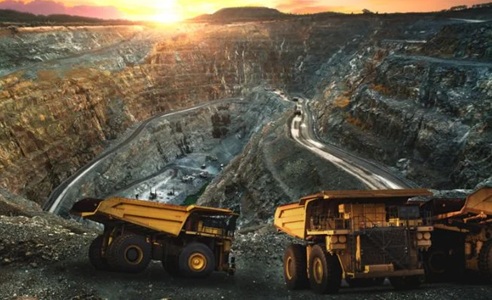The mining industry in India plays a crucial role in driving the nation’s industrial and economic growth. As we move through 2025, the sector stands at the intersection of modernization, sustainability, and global competitiveness. With rich mineral resources, government reforms, and the rise of automation and green mining, India’s mining landscape is witnessing a major transformation.
From coal and iron ore to rare earth minerals essential for clean energy and electronics, India’s mining sector continues to power industries such as steel, cement, power, and manufacturing — forming the backbone of the nation’s development.

Overview of the Mining Industry in 2025
India ranks among the top five mineral-producing countries in the world, with over 95 different minerals being produced — including 4 fuel-related, 10 metallic, 23 non-metallic, and 55 minor minerals. The mining sector contributes around 2.5% of India’s GDP, and its influence extends far beyond — feeding core sectors like infrastructure, manufacturing, and energy.
By 2025, the Indian mining market is estimated to reach USD 125 billion, growing steadily due to strong domestic demand, favorable policy changes, and increased private participation. The industry is being reshaped by new-age technologies such as AI-driven exploration, drone mapping, data analytics, and sustainable mining practices.
Key Growth Drivers in 2025
1. Policy Reforms and Investment Push
The government’s recent policy initiatives have been pivotal in attracting both domestic and foreign investment. The MMDR Amendment Act (2021) and the Coal Mines (Special Provisions) Act opened up commercial mining to private players, breaking decades of monopoly.
In 2025, policies under Atmanirbhar Bharat and the National Mineral Policy 2019 continue to encourage transparency, ease of doing business, and sustainable mining. The government aims to reduce mineral import dependence by 30% by 2030 through self-reliant exploration and efficient resource utilization.
2. Infrastructure and Technology Modernization
Technological adoption is reshaping how mining operates in India. Automation, Internet of Things (IoT), machine learning, and drone-based exploration are improving productivity and safety standards.
Major PSUs and private miners like Coal India Limited (CIL), Vedanta, Tata Steel Mining, and NMDC are investing heavily in smart mines equipped with remote sensing, real-time data analytics, and autonomous haulage systems.
Moreover, the development of Dedicated Freight Corridors (DFC) and logistics infrastructure under PM Gati Shakti is helping streamline mineral transportation and reduce costs significantly.
3. Rising Demand from Core Sectors
India’s ambitious infrastructure targets — including National Infrastructure Pipeline (NIP) and housing for all initiatives — are driving huge demand for steel, cement, and power. These, in turn, boost demand for iron ore, coal, bauxite, limestone, and copper.
Additionally, with the Make in India initiative promoting domestic manufacturing, sectors like automobiles, electronics, and defense are increasing consumption of key minerals and rare earth elements.
4. Green and Sustainable Mining
Sustainability is no longer optional — it’s a necessity. In 2025, India’s mining sector is witnessing a gradual transition toward eco-friendly operations.
Key initiatives include:
- Mine reclamation and afforestation programs.
- Increased investment in renewable energy for mining operations.
- Introduction of battery-electric mining equipment to reduce emissions.
Leading companies are also publishing ESG (Environmental, Social & Governance) reports, aligning with global sustainability standards.
Major Minerals and Regional Highlights
| Mineral Type | Key Producing States (2025) | Key Applications |
| Coal | Jharkhand, Chhattisgarh, Odisha | Power generation, steel |
| Iron Ore | Odisha, Karnataka, Chhattisgarh | Steel manufacturing |
| Bauxite | Odisha, Gujarat, Maharashtra | Aluminum production |
| Limestone | Andhra Pradesh, Rajasthan, Gujarat | Cement |
| Manganese | Madhya Pradesh, Maharashtra | Alloy steel |
| Copper & Zinc | Rajasthan, Jharkhand | Electricals, construction |
| Rare Earths | Andhra Pradesh, Jharkhand | EVs, electronics, renewable energy |
Challenges in the Mining Industry
Despite rapid progress, India’s mining industry in 2025 continues to face several challenges:
- Regulatory Delays – Lengthy approvals and overlapping clearances slow down project implementation.
- Environmental Concerns – Balancing mineral extraction with ecological preservation remains a complex issue.
- Infrastructure Gaps – Limited last-mile connectivity and logistics bottlenecks increase operational costs.
- Technology Adoption – Many small-scale miners still operate with outdated equipment and limited digital capabilities.
- Skill Shortage – There’s a growing need for trained professionals in mine automation, environmental safety, and resource management.
Opportunities Ahead
The mining industry in India 2025 presents immense opportunities for growth and innovation:
- Critical Minerals Exploration – With the rise of EVs, semiconductors, and renewable energy, India is focusing on lithium, cobalt, nickel, and rare earth exploration.
- Foreign Investment – Global mining giants are showing interest in India’s mineral blocks under transparent auction systems.
- Sustainable Mining Practices – ESG-focused mining offers opportunities for green financing and global collaboration.
- Value-Added Processing – Developing mineral-based industries near mining zones will enhance value addition and employment.
- Digital Transformation – Integration of AI, robotics, and IoT can make mining safer, smarter, and more profitable.
Future Outlook
By 2025, India’s mining industry is no longer just about extraction — it’s about innovation, sustainability, and strategic value creation. The government’s vision to transform India into a global mineral hub is backed by infrastructure development, policy reforms, and strong industrial demand.
As India moves toward its Net Zero 2070 target, the mining sector will play a critical role in supplying raw materials for renewable energy, EV batteries, and green technologies.
With public-private partnerships, digital innovation, and responsible mining, India’s mining industry is well-positioned to power the next phase of industrial growth — sustainably and efficiently.

